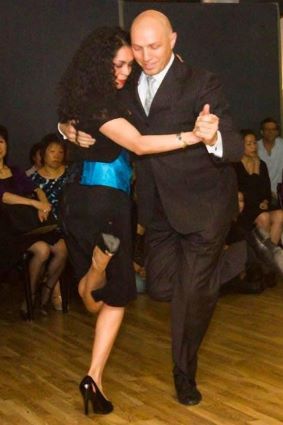Dance Styles at Dance Manhattan
Argentine Tango
Download the Study Guide
[word format]
There is a family of three dances from Argentina: Tango, Milonga and Waltz. They have similar step patterns but the rhythm of each is different. Milonga and Waltz are lighter, happier and faster than tango. The rhythm of the Milonga is like a syncopated march and it is danced in a very close embrace, chest to chest. Waltz is danced in half time.
Argentine Vals Video-Audrey Martinez & Guest Partner Tioma
Argentine Milonga Video-Jennifer Wesnousky and Guest Partner Ney Melo
More than just a dance, Tango is a way of moving. It is a passionate and sensual communication between two people, a way of interpreting the music, of moving together, of expressing feelings.
Argentine Tango Video-Jennifer Wesnousky and Guest Partner Orlando Reyes (improvised)
Argentine Tango Video-Guest Artist Rebecca Shulman
Tango was born in Buenos Aires at end of the 19th century. Originally developed by the poor immigrants in the ports, as their way of expressing loneliness, frustration, desire and energy, it was seen by the rest of the world as dangerous.
A close embrace, legs often entwined - a dance of passion.
Tango was popularized in the 1920's when some of the great tango songs were written, and various big tango orchestras started. It became socially acceptable and many young people started dancing it in ballrooms and at tea dances, both in Buenos Aires, and Paris. Now it is danced all over the world. Tango music can be slow and soulful, or fast and fun. It is beautiful to listen to, but even better to dance to!
Tango is improvised, so there are no sequences of steps that each dancer must laboriously learn by rote. Instead, they must learn to communicate with each other throughout the dance. Since it is improvised, one person must be in charge of leading the couple, deciding on the direction, and the beat, and what step to do next. This leader indicates to the follower where they want to go, and they both take the step. This doesn't mean the follower is passive. The follower has to let the the leader lead, listen with their body to what the leader is asking for, and be ready and balanced to execute any step as soon as they are asked to, without anticipating the next one.
At times, it feels like you are meditating with your partner, moving to the music together.
Argentine Tango Video-Valeria Solomonoff & special guest Jorge Torres
All you need to learn to dance Tango is the ability to walk, listen to the music and listen to your partner - and some patience!
This and future months’ Argentine Tango dance class schedule.




